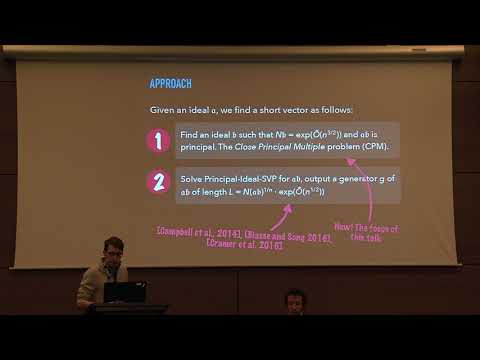Welcome to the resource topic for 2016/885
Title:
Short Stickelberger Class Relations and application to Ideal-SVP
Authors: Ronald Cramer, Léo Ducas, Benjamin Wesolowski
Abstract:The worst-case hardness of finding short vectors in ideals of cyclotomic number fields (Ideal-SVP) is a central matter in lattice based cryptography. Assuming the worst-case hardness of Ideal-SVP allows to prove the Ring-LWE and Ring-SIS assumptions, and therefore to prove the security of numerous cryptographic schemes and protocols — including key-exchange, digital signatures, public-key encryption and fully-homomorphic encryption. A series of recent works has shown that Principal Ideal-SVP is not always as hard as finding short vectors in general lattices, and some schemes were broken using quantum algorithms — the Soliloquy encryption scheme, Smart-Vercauteren fully homomorphic encryption scheme from PKC 2010, and Gentry-Garg-Halevi cryptographic multilinear-maps from Eurocrypt 2013. Those broken schemes were using a special class of principal ideals, but these works also showed how to solve SVP for principal ideals in the worst-case in quantum polynomial time for an approximation factor of \exp(\tilde O(\sqrt n)). This exposed an unexpected hardness gap between general lattices and some structured ones, and called into question the hardness of various problems over structured lattices, such as Ideal-SVP and Ring-LWE. In this work, we generalize the previous result to general ideals. Precisely, we show how to solve the close principal multiple problem (CPM) by exploiting the classical theorem that the class-group is annihilated by the (Galois-module action of) the so-called Stickelberger ideal. Under some plausible number-theoretical hypothesis, our approach provides a close principal multiple in quantum polynomial time. Combined with the previous results, this solves Ideal-SVP in the worst case in quantum polynomial time for an approximation factor of \exp(\tilde O(\sqrt n)). Although it does not seem that the security of Ring-LWE based cryptosystems is directly affected, we contribute novel ideas to the cryptanalysis of schemes based on structured lattices. Moreover, our result shows a deepening of the gap between general lattices and structured ones.
ePrint: https://eprint.iacr.org/2016/885
Talk: https://www.youtube.com/watch?v=jk43wvxrei0
See all topics related to this paper.
Feel free to post resources that are related to this paper below.
Example resources include: implementations, explanation materials, talks, slides, links to previous discussions on other websites.
For more information, see the rules for Resource Topics .
